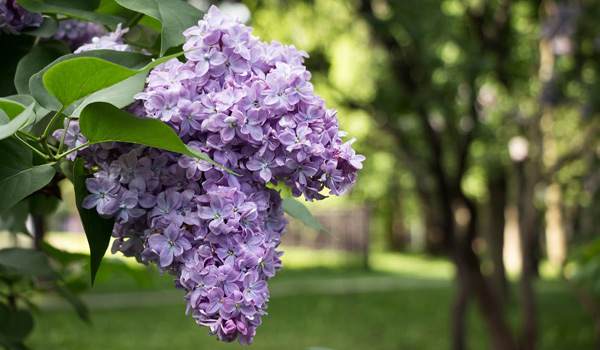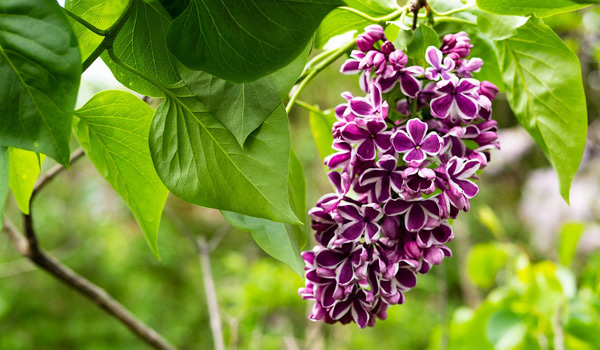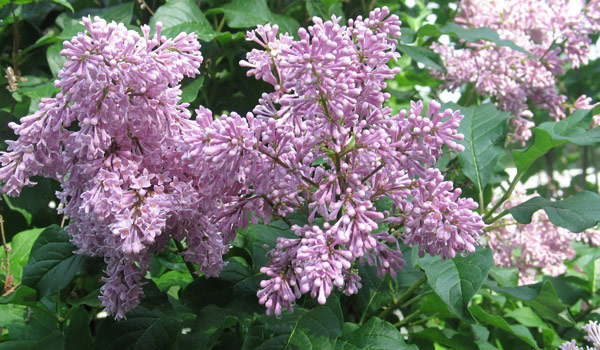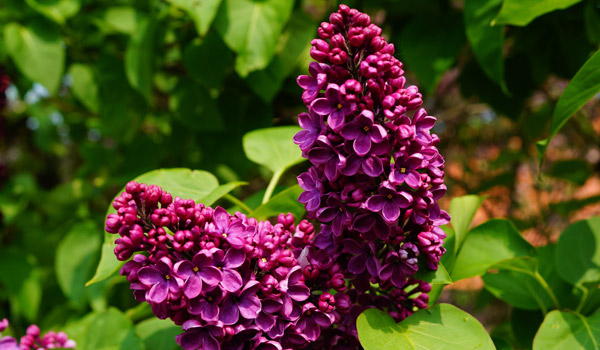Lilac Bush Care Guide + 8 Popular Types

Widely known for its sweet fragrance and vibrant blooms, the lilac bush (Syringa vulgaris) is a popular ornamental plant native to Europe. As a member of the Oleaceae genus, you may also know this plant as the lilac tree.
It has grey-brown bark, 2 to 5 inch-long blue-green leaves, and small white or purple blooms that appear in the spring. With a growth rate of 1 to 2 feet in a year, the lilac plant reaches 8 to 15 feet in height and 6 to 12 feet in width in the wild.
In the following parts, we are going to introduce some of the favored types of lilac bushes, their requirements, common problems, and other related info that you will need for growing this lovely shrub.
Types of Lilac Bushes
Due to extensive breeding, it is not easy to identify lilacs from one another, even for professionals. Hopefully, this brief guide will help you realize the main attributes of types of lilac bushes to guess the variety correctly.
Also, if you already do not have a lilac shrub in your landscape, you may find your favorite and add it to your collection. In addition to the common lilac (Syringa vulgaris), these are the most common types of lilac bushes:
- Persian Lilac: Looking for a variety to adorn an informal hedge? Consider this type. Growing up to 10 feet in height, the pale flowers of Syringa persica create a unique view in designing landscapes.
- Dwarf Korean Lilac: If you want the lilac bush size to be compact, this would be the ideal choice. Growing only 4 feet, this species produces similar blooms to the common type and makes for a perfect informal hedge plant.
- Sensation Lilac: This gorgeous lilac tree features clusters of purple blooms with white edges, occasionally reverting to solid white. This variety has a standard size, growing 8 to 10 feet tall and 8 to 12 feet wide.
- Himalayan Lilac: Also known as the late lilac, you may identify this type of lilac bush by its rose-like blossoms. Reaching 10 feet in height, Hungarian lilac is a similar species with darker blooms.
- Tree Lilacs: Now this is a real lilac tree! This variety can grow as tall as 30 feet with its off-white flowers adorning it. You may also like the Japanese Tree Lilac, which is mostly known for its very pale-yellow blooms.
- Tinkerbelle Lilac: Those who prefer lilac flowers in a non-traditional color favor this plant frequently. The wine-red blooms appear in late spring and have a spice aroma that attracts butterflies. Speeding 8 feet in height and 4 to 5 feet in width, this in a smaller lilac plant.
- Chinese Lilac: Also called the Rouen lilac, this version is a cross between common and Persian lilacs. It quickly grows up to 8 to 12 feet and it is considered one of the best types of lilac bushes for summer screens or hedges.
- Charles Joly Lilac: This old yet still popular variety boasts deep purple flower buds that later turn into magenta blooms with a strong fragrance. Since it tends to sucker, they are also a suitable choice for informal screens.

Lilac Bush Care
All the attractive types of lilacs are mainly grown as focal points in landscapes or in rows along property borders as loose hedges. Regardless of how you want to benefit from these eye-catching shrubs, once established, lilac bush care is quite convenient.
Watering
To help this bush establish a deep root system, you need to water it regularly. However, unlike young plants that thrive better in soil that is slightly moist (note that soggy soil leads to root rot), water mature ones weekly in dry conditions.
If there is extreme heat, water more. If irrigation is not sufficient, these leaves will appear wilted or distorted. Also, water the lilac flower at the soil level and avoid overhead watering.
Light
The lilac tree is not a suitable plant for hot (as well as humid) areas, but it appreciates receiving full sun at least six hours a day. Keep in mind that very strong sunlight can turn the leaves brown. It also tolerates some shade, but too little light can limit its bloom.
Similar to full shade, they do not do well against winter winds. This plant can handle temperatures well below freezing, but it is recommended to protect your lilac bush in winter, especially from its infamous winds.
Soil
In lilac bush care, provide it with moist, well-drained, and slightly alkaline soil. A rich, loamy potting mix with proper drainage and a neutral soil pH will do just fine. Since they prefer rich soil, add compost if needed.

Fertilizer
To enjoy lilac flowers, you should not over-fertilize it. Feed your plant with a small amount of 10-10-10 in late winter. Too much fertilizer can also damage the foliage and make it brown.
Do not use fertilizers high in nitrogen which can lead to poor blooming.
Encouraging Lilac Flower
As mentioned earlier, these lovely plants bloom in springtime (mid-to-late spring to be precise). The exact timing differs for each variety. The blooms on a healthy plant last for one to two weeks and readily rebloom each year.
To get the white lilac bush or other types to bloom, there is no need to deadhead or remove the spent flowers. However, insufficient light causes poor flowering. So, watch your plant for a full day to make sure it does not experience shade for a long time.
Lightly moist soil also promotes lilac flowers. Water regularly or use mulch to maintain moisture and kill the weeds that might compete with your plant. To enjoy the clusters of tiny four-lobed flowers for a longer period, you may also consider planting various types of lilac bushes that flower at different times.
Tip: Cutting them at a slight angle, the charming blooms are excellent cut flowers and will last 3 to 5 days in fresh water. Cut them before they are fully open.
Pests and Diseases
These fairly hardy shrubs survive most of the typical pests and diseases, but they are somewhat vulnerable to some including powdery mildew, especially during humid summers.
Although usually not fatal, you need to treat your lilac plant as soon as you notice whitish powdery patches on the foliage using chemical fungicides and natural methods.
Common pests like scales and borers can affect this plant and damage their foliage too. Upon spotting these insects on the stems and/or under the leaves, treat the lilac shrub with neem oil or other insecticides.

Lilac Bush Out of Control?
An important part of purple or white lilac bush care is how to prune it. Correct pruning encourages lilac flowers, offers air circulation to prevent problems such as powdery mildew, and boosts its health.
Soon after flowering, you can prune your plant. Do not postpone so that next year’s flowers are not sacrificed. For trimming, start with removing dead, diseased, or damaged branches. Then, deadhead spent blooms and remove root suckers (if you have a grafted plant).
With pruning in lilac bush care, you can even rejuvenate older. But you need to be harsh and trim down such plants as low as 6 to 8 inches. Remember that it may take a few years to grow back completely, and blooms will decrease in the first couple of years.
Propagating Lilac Tree
Lilacs are clump-forming, meaning that they produce new shoots from the trunk base. You can use these shoots for lilac tree propagation.
In early summer, dig down from the main clump and when the roots are exposed, remove a shoot (including the roots) away from the main bush. Plant the shoot in a suitable spot and keep the soil slightly until it is established.
Note: This method is not recommended for grafted varieties.

How to Start a Lilac Bush from Seed?
Starting a white lilac bush or other types from seeds is more challenging. For propagation using seeds, follow these instructions:
- Soak the seeds in a shallow bowl of tap water for a day. Drain the seeds on a sheet of paper the next day.
- Add lightly moistened perlite into a sealable storage bag and press the seeds into the perlite until they are covered. Seal the bag and place it in the refrigerator to imitate winter conditions.
- Leave the seed for two months in the refrigerator. During this period, do not allow it to dry out completely, and moisten the perlite with water spray whenever it feels dry.
- After this time, fill 4-inch pots with proper soil. Plant the seeds at a 1/4-inch depth and cover them with a very thin layer of soil to insulate them. spray water onto the soil until the top 1 inch is moist.
- Place the containers near a bright window and keep them warm using a propagation mat set to 70 F. Maintain the soil moisture during the germination process too.
- The first sprouts will show after a month. Keep using the propagation mat for two more weeks. After removing it, grow the young lilac plants in the cold frame until spring.
- After the last frost, move them to a lightly shaded spot outdoors and transplant them into larger containers (filled with suitable soil, discussed above) once roots appear near the drainage holes.
- Grow them under light shade and water each week until mid-autumn. Now you can move them into a permanent bed in a proper spot, 5 to 10 feet apart from other lilac trees depending on the variety.
- In this post:
- Types of Lilac Bushes
- Lilac Bush Care
- Lilac Bush Out of Control?
- Propagating Lilac Tree



